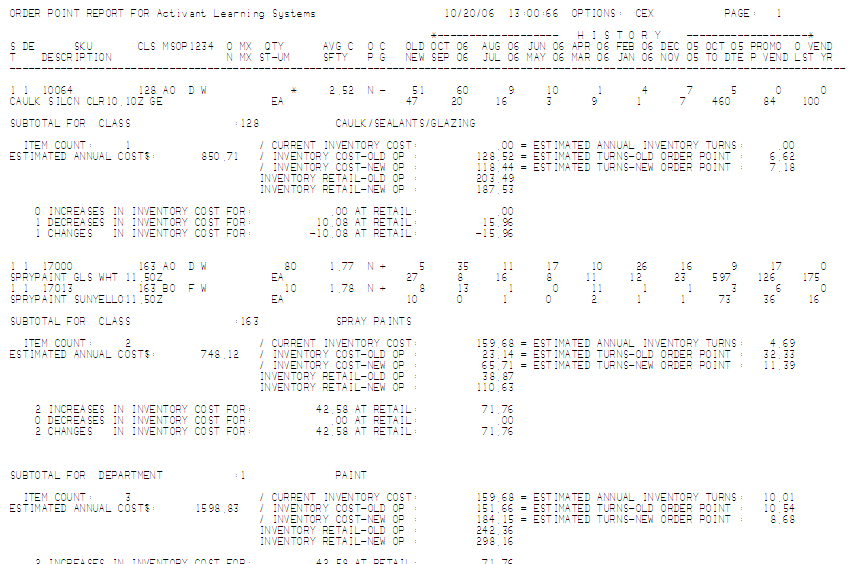
This topic provides an example of the Order Point report (ROP) and definitions of the fields on the report. For more information about ROP and procedure steps for running the report, click here to go to the online help topic. This report is available from both the Eagle Browser and Network Access.
The following is an example of the report. Click a field in the report to take you to the field definition.

The following is a list in alphabetical order of the fields on the ROP report.
AVG C - Average cost. The system automatically updates average cost. The calculation is:[(receipt cost x qty received) + (old average cost x QOH before receipt)] divided by new QOH.
CG - Change. Did the order point increase (+) or decrease (-)?
CLS - The class assigned to an item. On reports, this is actually the code you assigned to a specific class in Class Maintenance (Function MCL). The class may consist of numbers and/or letters.
DE - The department assigned to an item. On reports, this is actually the code you assigned to a specific department in Department Maintenance (Function MDE). The department may consist of number and/or letters.
DESCRIPTION - The name of the item. This information comes from Item Maintenance (Function IMU).
LST YR - Last year's sales units.
MSOP1234 - These codes identify certain types of items. All of the codes come from Item Maintenance (IMU).
M - popularity code
S - seasonal code
O - order indicator
P- promotional code. This field will show a P if the item is on a regular promotion. The P position will show an L if the item is on a loyalty promotion. If the item is on both a regular and loyalty promotion, it will show a P.
1 - user code, first position
2 - user code, second position
3 - user code, third position
4 - user code, fourth position
N MX - New Maximum stock level. This is the stock level after the Order Point Report (Report ROP) has run.
NEW - New order point. This figure is displayed on bottom.
O MX - Old Maximum stock level. You can increase or decrease maximum stock level according to changes in order point.
O VEND - Other vendor purchases. How many units were purchased from anyone other than your primary vendor?
OLD - Old order point. This figure is displayed on top.
OP - Order point protect (from Inventory Maintenance (Function IMU). If this field is Y, this item's order point is protected, and will never be changed by Report ROP. If this field is N, this item's order point is not protected.
PROMO - The year-to-date promotion units (from Inventory Maintenance (Function IMU). The expanded sales history promotion units are not included in this amount.
P VEND - Primary vendor purchases. How many units were purchased from your primary vendor?
S - The store where the item is stocked.
SFTY - The safety stock for the item.
SKU - SKU # (Stock Keeping Unit). This is the number you use to identify the item.
ST-UM - Stocking Unit of Measure.
TO DTE - The sales units sold to date (from Inventory Maintenance (Function IMU).